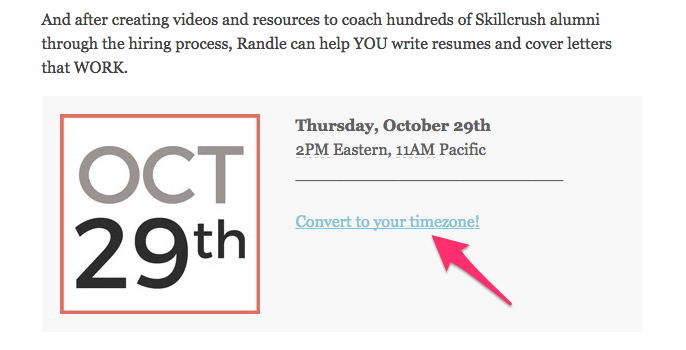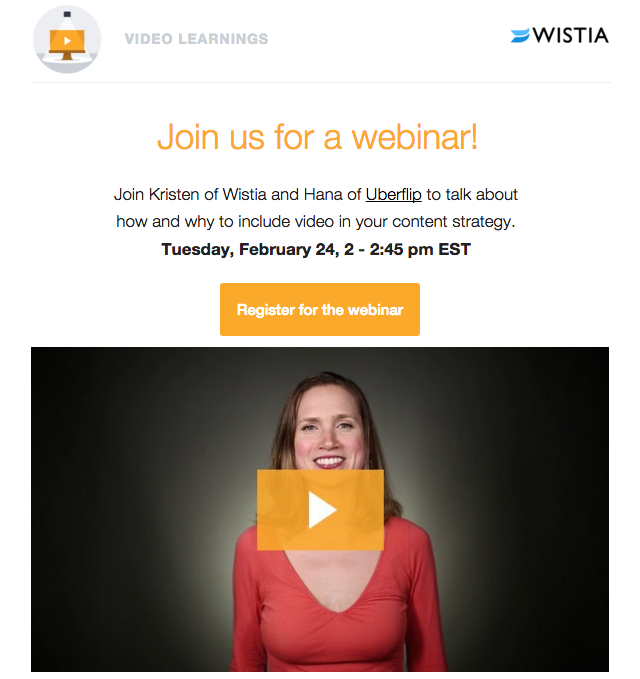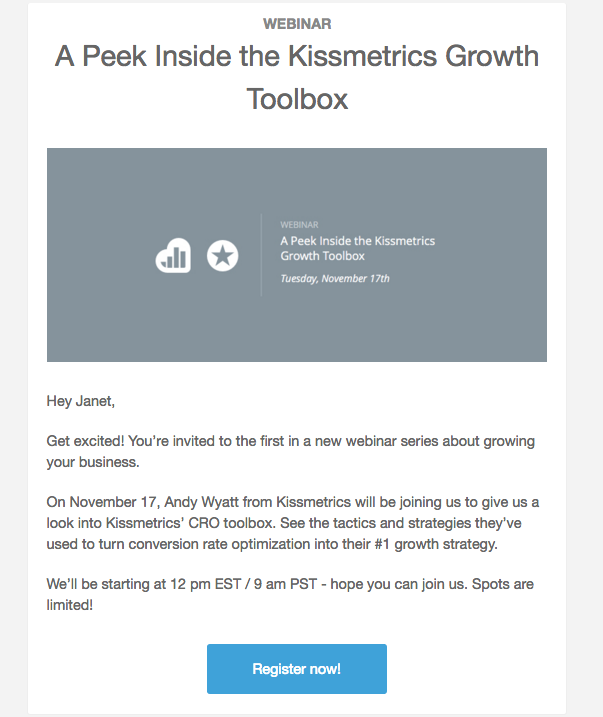
How to Create Webinar Invitations that Drive Registrations
The webinar is the marketer’s party. Okay, these learning and lead-generation gatherings probably aren’t as fun without the punch bowl and perfect playlist — but at the planning stages, there’s the same fear. What if nobody shows up?
For webinars (and, presumably, parties) — it all comes down to the invitation.
Email is simply the most effective channel for promoting webinars. 2012 data from BrightTALK show 58-64% of people attending thanks to email and direct invitations. The 2013 ON24 Webinar Benchmark Report states that 80% of registrations come from a combination of email and site promotions.
Your webinar invitations also deserve their own emails. Justine Jordan, VP of Marketing at Litmus, advises that you go beyond tacking on promotional mentions on regularly scheduled marketing messages:
[S]end a stand-alone email! We used to send newsletters with webinar registration links inside, but have found that sending dedicated emails for each webinar results in many more registrations.
Georgiana Laudi, VP of Marketing at Unbounce, also reports: “70% of all our webinar registrations come via our invitation emails.” For our own upcoming welcome email webinar, we can thank our dedicated invitation emails for 76% of registrants so far.
That’s all to say — your invitation emails are vital to a successful webinar! Let’s look at how to make them super effective to bring more people to your web party.
The Essential Ingredients for the Webinar Invitation
Webinar invitation email are all about making it easy for people to say yes and see what the value is for them. Here are all the ingredients you need:
- WHAT: Webinar title
- WHEN: Date and time of the webinar
- WHO: Introduce the people presenting, especially if there’s a guest
- HOW: Calls to action to register (buttons, links, etc.)
- WHY: What’s in it for the reader? What problem will you help them solve?
- WHAT: What will people learn? What should they expect from the presentation?
- CARE: The invitation is an early exercise in being a great and empathetic host. Make it easy to sign up. Address blockers by informing folks whether the recording will be available if you can’t attend the live event. Set expectations by being clear about any Q&As.
Here’s an example from Litmus of all those elements at work:
7 Tips to Optimize Your Webinar Invitations
Now let’s explore some tips to make those ingredients shine.
1. Have Time Zone Empathy
The challenge of coordinating any type of meeting online, whether it’s an interview, chat, or your amazing webinar, is getting timezones correct. You’ve probably put thought into scheduling your webinar at a time that makes sense for your audience — but don’t make your readers have to do timezone math (which, for some reason, is always more complicated than regular math).
Most people attempt to account for this by including 2-3 timezones in their invite. Some even go so far as to provide a link to a timezone converter. But the best treatment of timezones in webinars invitations that I’ve seen come from Litmus and Skillcrush.

Skillcrush provides a handy “Convert to your timezone!” link, which sends you straight to a page with the correct conversion. You can use timeanddate.com’s handy Event Time Announcer to set up this type of link for your own invitations.

Similarly, Litmus provides a helpful “View in your timezone” link — which leads you to a Permatime page that shows you the date and time in your local zone (according to your computer settings). With Permatime, you can also add a label and link to your event:
Update: Permatime is no longer around, but you can check out Every Timezone

2. State the Problem
Spelling out the problem or challenge is an effective tactic for two reasons. It forces you to take on the perspective of your audience — and provides a great lead-in to your description of what people can take away from the presentation if they sign up. That “you have this problem” plus the “we help you solve it” one-two punch ultimately helps to craft a compelling pitch.

Email on Acid promises to solve a common problem that haunts most email marketers: the Great Fear of Hitting Send. This approach results in much more compelling copy, like the call-to-action to “eliminate that awful pit in your stomach,” than something blah like “learn the best practices of email deliverability”
Here’s a great example from Unbounce that also pinpoints a problem that causes doubts and insecurity:

The pain of getting copy to pop is real. Unbounce taps into that and promises to deliver “a foolproof system for writing targeted, persuasive copy for all your landing pages—without losing your mind.” Who wouldn’t want that!
That leads perfectly into the 4 concrete lessons that you’ll take away from attending the webinar.

3. Make a personal connection.
The fact that you’re writing as a business or professional is never a reason to sound like you’re filling out a corporate fill-in-the-blanks form. Even if there’s a bit of a formula to webinar invitations, what will make your message compelling and convincing is your ability to connect as people.
# Use images of people

Simply by providing photos of the people involved in a webinar, Bit.ly makes their invitation more appealing and warm. The way they’ve formatted their email is also helpful — everything you need to know at a glance, right at the start. Invitation messages are no occasion to bury the lede.

Wistia’s screenshot of a video with Kristen not only shows a human face behind the upcoming webinar but it’s also a simple, inviting way for people to find out more about the event. You could create one or two teaser videos to capture interest and strengthen people’s motivation to actually attend the webinar live.
# Talk like a real, live person
Making a personal connection can be accomplished simply with tone and style. Joanna Wiebe is one of the best copywriters out there — and of course her webinar invitation doesn’t disappoint.

In a matter of 10 lines or so, she gets across everything you need to know, from identifying the existing challenge, the promise of a solution, and details. This checks off all the webinar invitation elements, and it’s done in a succinct, totally relatable way, signing off with a casual, personable “See you there, jo”
# Send a simply-formatted, unbranded message

Hana Abaza, VP of Marketing at Uberflip, takes the personal approach with this text-focused, simply-formatted email. No logos, no images — just a message written as if she wrote it to you in her Gmail account. The “What are you doing this week?” line is an interesting change-up from the usual announcement of the webinar in the subject.
4. Tap into FOMO (Fear of Missing Out)
While persuasion principles are handy in marketing your webinar overall, the scarcity principle is especially fitting to add motivation oomph to emails. Scarcity is persuasive because people tend to want what they can’t have. You’ll find examples of this when you see language expressing a scarcity of time or space — “now”, “limited seats”, “special invitation”, “time’s running out”, etc.
Here’s an invite from Iris Shoor at Startup Moon that applies the scarcity principle 4 times in her copy. Can you identify them all?

- “special invite for you”
- “exclusive webinar”
- “Spots are limited.”
- “We want to bring you more than what you can find on Google.” Promising exclusive knowledge in your webinar is a smart touch.
5. Target your invitations
Target your webinar invitations at specific segments of your userbase and email lists. It’s the golden rule of email at work — relevance, first — and your metrics will improve across the board. Not only will have a better chance of successful conversions (webinar registrations), you’ll reduce needless unsubscribes and damaging spam reports.
Check out this webinar invitation email from Mention:

While it might not look very different from the other emails in this post, this invitation was specifically sent to Mention users who work in marketing. By targeting an audience who’s more likely to be interested in this webinar’s subject — conversion rate optimization and growth — Mention is increasing their chances of success to drive registrations without annoying the rest of their userbase.
Here are some additional ideas for segments you can target:
- engaged newsletter readers
- someone who downloaded an ebook or resource recently
- recent signups to your product
- a specific segment of your userbase
- attributes like job role or signup source
We took a page from 15Five’s winback email strategy to send out webinar invites to lapsed and inactive Customer.io account-holders. That segmentation resulted in 76% of registrations so far.
6. Send a sequence of emails
Webinar email campaigns span more than the invitation itself. There are teasers, confirmation message with logistics and details, and follow-ups. But that doesn’t mean you should only send one dedicated invitation email.
Send at least two invitation emails, with the second one coming close to the date of the webinar. That way you can put the time scarcity persuasion principle to work — with phrases like “last chance”, “time’s running out”, “only X days/hours” to motivate in your copy and subject line. Multiple invitation emails are also a great opportunity to try different angles and tactics to entice readers.
7. Don’t forget the details.
Go straightforward with the subject line.
And for the from name, we recommend going with the familiar and following whatever pattern your recipients are used to. Just make sure not to overlook the “from name” detail — you might end up with something by mistake like “webinars”.

Of course, at the end of the day, testing is the best way to see what works. (Joanna has some great insight and advice on the from-name and subject line.)
Lastly, I thought I’d share some links to resources on holding webinars I found particularly helpful.
- Unbounce’s The Smart Marketer’s Guide to Webinar Marketing
- Unbounce also has a great blog post about planning webinars that pre-dates the more comprehensive guide.
- Zapier’s How to Create a High-Converting Webinar Landing Page Without Writing Any Code
- Mention’s Everything You Need to Know About Running a Webinar (And Then Some)
- Copyhacker’s Are Webinars Part of Your Growth Hacking Plan This Year?
What are some winning touches or missteps you’ve seen in webinar invitations? We’d love to hear, so share in the comments!
